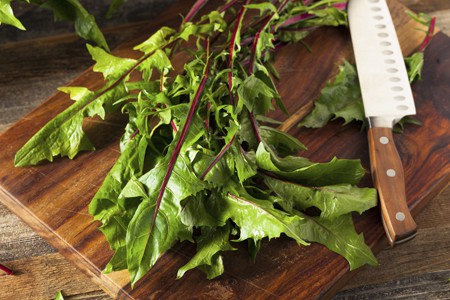Are you one of the many millions of people who, even though you know how essential leafy greens are for your health, you—yes, you—nevertheless find at the end of the week that once again, you’ve not eaten any leafy greens! The feelings of remorse and guilt creep back for the umpteenth time, and with a deep sigh of disappointment in yourself, you unconvincingly promise to do better. Well, guess what? You’re not alone. Welcome to the club!
Here are the usual steps you, like me, may have repeated many times:
- You sincerely determine to eat more leafy greens.
- You dutifully put them on our grocery list.
- You buy lots of the best and freshest greens you can find.
- Two weeks later you sadly take them out of the refrigerator only to see a slimy yellow substance on them! (Sigh.)
- Now you need to toss them into the garbage pail or, at best, compost them.
- All the while you shake your head with remorse, muttering under your breath that once again, you’ve failed to eat your greens. Plus you’ve wasted money you could have used elsewhere. I call this the “Leafy Green Guilt Syndrome.” (Smile.)
I confess, this has happened to me way too many times. I’ve asked myself repeatedly, Why is it I don’t eat my greens? Well, frankly, for many of us they’re simply flavorless. Countless others aren’t sure how to cook them so they’re tasty. The result is that we subconsciously keep telling ourselves, “I’ll cook them tomorrow, I’ll cook them tomorrow.” But tomorrow never comes. Sound familiar?
After much reflection, I realized I was honestly tired of feeling bad about tossing out perfectly good food. That was a few months ago, and I began to search for information, recipes, and a deeper understanding that would give me the ultimate incentive to follow through.
While doing that research and looking for tasty recipes, I eventually discovered the sweet secret of leafy greens. Along with that new find and the many other wonders I’ve discovered anew about leafy greens, a profound metanoia (a genuine change of heart) is what finally turned my attitude around. I am now enjoying not wasting my hard-earned greens (pun intended). Hopefully, this information and a few recipes will also give you a jumping off platform that will help you start eating more of these intensely nutritious foods.
Oh Sweet Sulfoquinovose
This information is so important that rather than paraphrase it, allow me to introduce you verbatim to the one study that, in addition to all my other research, finally reignited my enthusiasm about judiciously including leafy greens in my diet. After that I will talk about many other good things to know about greens and offer some easy recipes. The following quote is from “Sweet Discovery in Leafy Greens Holds Key to Gut Health.” (Emphasis in the last paragraph is my own.)
“A critical discovery about how bacteria feed on an unusual sugar molecule found in leafy green vegetables could hold the key to explaining how ‘good’ bacteria protect our gut and promote health.
“The finding suggests that leafy greens are essential for feeding good gut bacteria, limiting the ability of bad bacteria to colonize the gut by shutting them out of the prime ‘real estate.’
“Researchers from Melbourne and the UK identified a previously unknown enzyme used by bacteria, fungi and other organisms to feed on the unusual but abundant sugar sulfoquinovose—SQ for short—found in green vegetables.
“Each year, leafy green vegetables—such as spinach—produce the sugar on an enormous scale globally, comparable to the world’s total annual iron ore production.
“The research, published today in the journal Nature Chemical Biology, was led by Dr. Ethan Goddard-Borger from the Walter and Eliza Hall Institute, Professor Spencer Williams from the Bio21 Institute and University of Melbourne, and Professor Gideon Davies from the University of York, UK.
“Dr Goddard-Borger said the discovery could be exploited to cultivate the growth of ‘good’ gut bacteria. ‘Every time we eat leafy green vegetables we consume significant amounts of SQ sugars, which are used as an energy source by good gut bacteria,’ he said.”
Some other important points to ponder as you read on include:
- Raw or Cooked Greens
- A Closer Look at the Nutritional Value of Leafy Greens
- Eat Your Greens! Recipes Worth Exploring
 Raw or Cooked Greens
Raw or Cooked Greens
The studies I’ve been exposed to through the Weston A. Price Foundation and Sally Fallon Morrell caution that specific foods that contain a substance called goitrogens, including cruciferous vegetables such as broccoli, cabbage, spinach, kale, and others, should be steamed or cooked for a minimum of 15 minutes prior to eating. However, other studies indicate that we need not be concerned about goitrogens. Read the article “An Up-to-Date Look at Goitrogenic Substances in Food” to learn more. I now consider this a personal decision and find it less stressful to simply recommend that you do your own study on this controversial subject.
Note: I would caution the many who eat raw spinach either in smoothies or in salads that spinach and other high oxalic acid foods may be detrimental if you frequently eat them raw.
A Closer Look at the Nutritional Value of Leafy Greens
Here’s a list of the more popular and easily sourced greens, along with information about their nutritional value.
Note: An important caveat to keep in mind as you look over the following list is to include healthy fats, and particularly butter (raw preferred). This allows for better absorption when we eat vegetables and/or leafy greens.
Kale: Researchers can now identify over 45 different flavonoids in kale. With kaempferol and quercetin heading the list, these flavonoids—plus kale’s high content of vitamin K, A, and C and its anti-inflammatory benefits—suggest that kale can play a leading dietary role with respect to avoiding chronic inflammation and oxidative stress.
Collards: We derive unique health benefits from collard greens in the form of its cancer-preventive properties, which may be largely related to four specific glucosinolates found in this cruciferous vegetable: glucoraphanin, sinigrin, gluconasturtiin, and glucotropaeolin. Each of these glucosinolates can be converted into an isothiocyanate (ITC) that helps lower our cancer risk by supporting our detox and anti-inflammatory systems.
Turnip greens: The noticeably bitter taste of turnip greens has been linked by researchers to its calcium content. On an ounce-for-ounce basis, turnip greens contain about four times more calcium than much less bitter-tasting cruciferous vegetables such as cabbage. Even in comparison to mustard greens, turnip greens contain about twice the calcium content. High calcium content is not the only reason for the noticeable bitterness of turnip greens, of course. But it may be an important contributing factor.
Spinach: Bright, vibrant-looking spinach leaves are not only more appealing to the eye but more nourishing as well. Recent research has shown that spinach leaves that look fully alive and vital have greater concentrations of vitamin C than pale spinach leaves. The study authors suggest that the greater supply of vitamin C helps protect the oxygen-sensitive phytonutrients in the spinach leaves, which makes them look vibrant and alive.
Mustard greens: For total glucosinolate content, mustard greens rank high on the list of commonly eaten cruciferous vegetables. In one study, they were second only to brussels sprouts in terms of total glucosinolate content. Glucosinolates are phytonutrients that provide us with unique health benefits because they can be converted into isothiocyanates (ITCs) that have cancer-preventive properties. All cruciferous vegetables have long been known to contain glucosinolates, but recent research has made us realize how valuable mustard greens are in this regard.
Broccoli: We’re experiencing an epidemic of vitamin D deficiency, and broccoli may help us solve it. When large supplemental doses of vitamin D are needed to offset deficiency, ample supplies of vitamin K and vitamin A help keep our vitamin D metabolism in balance. Broccoli has an unusually strong combination of both vitamin A (in the form of beta-carotene) and vitamin K. For people who need to rebuild vitamin D stores through supplements, broccoli may be an ideal food to include in the diet.
Cabbage: In general, cabbage—Savoy cabbage in particular—turns out to be an especially good source of sinigrin, one of the cabbage glucosinolates that has received special attention in cancer prevention research. The sinigrin in cabbage can be converted into allyl-isothiocyanate, or AITC. This isothiocyanate compound has shown unique cancer preventive properties with respect to bladder cancer, colon cancer, and prostate cancer.
Eat Your Greens! Recipes Worth Exploring
Moroccan Beet Greens
—Adapted from Goop. Makes 2 servings.
Ingredients
3 bunches beet greens, red stems removed
2 tablespoons olive oil, plus 1 tablespoon for serving
2 cloves garlic, grated
¼ teaspoon cumin
1 teaspoon paprika
1 pinch salt
¼ preserved lemon (I just used fresh lemon)
1 tablespoon cilantro, chopped
1 tablespoon parsley, chopped
1 pinch hot red spice, crushed pepper flakes, chili pepper, or paprika
Instructions
- Wash greens and leave them in a bowl full of cold, clean water.
- Add 2 tablespoons olive oil to a saucepan set over medium-high heat. When just warm, add grated garlic, cumin, and paprika. (Be careful the oil is not too hot or the garlic and spices will fry and burn. You want just a little reaction to the heat.)
- As soon as the garlic becomes fragrant, remove greens from the water. Do not drain. Chop coarsely, then add to the pan. Turn the heat to medium and give everything one good stir to coat the greens with the spices. Cover tightly, turn down the heat, and simmer for 5 minutes. Check to ensure that it doesn’t burn. If you’re worried, add a little water.
- Meanwhile, slice preserved or fresh lemon into ¼-inch cubes or slices. Reserve a couple for decoration. Add remaining lemon, cilantro, and parsley to the pan. Stir everything. Cover and let cook for 5 more minutes.
- To serve, drizzle about one tablespoon of good olive oil on top. Garnish with the preserved or fresh lemon, and add a sprinkle of hot spice, pepper flakes, chili powder, or paprika if you don’t like hot spice. This goes well with a fried egg and is usually eaten with bread.
 Leafy Green Creamed Beverage
Leafy Green Creamed Beverage
This is one of my own easy ways to combine or use single leafy green vegetables as a creamed beverage along with my regular meal. It serves the purpose, and I can prepare my greens as soon as I get back from grocery shopping. They’re ready to go, so no more spoiled greens!
Ingredients
Any green leafy vegetable or green vegetable (asparagus, broccoli, etc.)
Approximately 1 cup raw milk (preferred) or whole fat organic pasteurized milk (avoid ultra-pasteurized)
Approximately ¼ cup raw cream (preferred) or organic pasteurized cream (avoid ultra-pasteurized)
1 garlic clove
Spices of your choice, to taste
2 tablespoons butter (optional)
Salt, pepper, or cayenne, to taste (optional)
Instructions
- Steam or simmer greens in softly boiling water for 15 minutes. Drain in a colander, and allow the greens to cool in the refrigerator. For leafy greens, once they’re cool squeeze the water out really well with your hands and freeze immediately. For vegetables (broccoli, asparagus, etc.) just allow them to cool, then freeze.
- When you anticipate wanting your greens, thaw them overnight in the fridge. Place thawed greens in a Vitamix or your blender. Add milk and cream. Add garlic and any other spices you like. Blend well.
- Heat beverage slowly over medium-low to medium heat.
- To make this a fat burning beverage as outlined in my blog post “Fat Burning Foods,” add butter, salt, pepper, or even a touch of cayenne powder.
- Pour into your favorite mug and sip away with any meal or by itself.
Stir-Fried Kale with Slivered Carrots
—Adapted from SparkPeople.
Ingredients
¾ lb. fresh kale
2 teaspoons coconut oil, lard, or tallow
2 carrots, peeled and cut julienne
2 garlic cloves, minced
1 teaspoon ground coriander
Salt and freshly ground pepper to taste
Instructions
- Rinse kale and remove stems, including large stem running through center of each leaf. Place a few leaves on top of each other and cut into thin strips. Repeat until all kale is cut.
- Add kale to pot of boiling water and boil uncovered 10 minutes. Drain and set aside.
- In large skillet, heat oil over medium-low heat. Add carrots and sauté 2 minutes. Add garlic and sauté 1 more minute. Add coriander, salt, and pepper and cook 2–3 additional minutes. Add kale and cook 1–2 minutes.
Spinach and Artichoke Egg Casserole
 — Adapted from Two Peas & Their Pod. This easy egg casserole recipe is perfect for a quick and healthy breakfast, brunch, or dinner. It’s also great for holidays!
— Adapted from Two Peas & Their Pod. This easy egg casserole recipe is perfect for a quick and healthy breakfast, brunch, or dinner. It’s also great for holidays!
Ingredients
1 tablespoon coconut oil, plus more for greasing dish
½ yellow onion, diced
2 cloves garlic, minced
6 cups packed fresh spinach
1½ cups chopped jarred artichoke hearts (packed in water and drained)
¼ teaspoon dried oregano
1 tablespoon finely chopped fresh basil
Dash crushed red pepper
Salt and black pepper, to taste
1½ cups shredded mozzarella cheese, divided
¼ cup grated Parmesan cheese, plus 2 tablespoons, divided
8 large organic eggs (soy free feed preferable)
3 tablespoons organic whole fat milk
Chopped basil, for garnish, if desired
Instructions
- Preheat oven to 350°F. Coat baking dish with coconut oil and set aside.
- In a large skillet, heat 1 tablespoon coconut oil over medium heat. Add onion and cook until tender, about 3 minutes. Add garlic and cook for an additional 2 minutes. Stir in spinach and cook until wilted, about 3–4 minutes. Stir in chopped artichoke hearts. Add dried oregano, fresh basil, and crushed red pepper. Season with salt and black pepper, to taste.
- Pour mixture into prepared pan and spread out evenly. Sprinkle 1 cup of the mozzarella cheese and ¼ cup Parmesan cheese over the mixture.
- In a medium bowl, combine eggs and whole fat milk. Whisk well. Pour eggs over veggies and cheese. Top with remaining ½ cup mozzarella cheese and 1 tablespoon Parmesan cheese. Sprinkle additional chopped basil over the top, if desired.
- Bake 30–35 minutes or until eggs are set and slightly golden around the edges. A knife inserted into the center should come out clean. Remove from oven and let cool for 10 minutes. Cut into squares and serve warm.
AUTHOR’S NOTE
To choose your organically grown and fresh ingredients wisely, use the following criteria:
- chemical- and hormone-free meat
- wild-caught fish
- pasture-raised, organic eggs
- whole, unrefined grains
- virgin, unrefined, first-press organic oils
- whole-food, unrefined sweeteners
- pure, clean, spring water
- sea salt
- raw and/or cultured milk and cream products
Photos from iStock/kieferpix (at top); Tatiana Belova (veggies); Olha_Afanasieva (spinach casserole); bhofack2 (dandelion greens)
Note from Maria: I am a Certified Natural Health Professional, CNHP, not a medical doctor. I do not diagnose, prescribe for, treat, or claim to prevent, mitigate, or cure any human diseases. Please see your medical doctor prior to following any recommendations I make in my blogs or on my website.



 Raw or Cooked Greens
Raw or Cooked Greens Leafy Green Creamed Beverage
Leafy Green Creamed Beverage